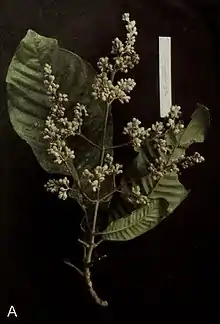| Rustia | |
|---|---|
 | |
| Rustia bilsana | |
| Scientific classification | |
| Kingdom: | Plantae |
| Clade: | Tracheophytes |
| Clade: | Angiosperms |
| Clade: | Eudicots |
| Clade: | Asterids |
| Order: | Gentianales |
| Family: | Rubiaceae |
| Subfamily: | Ixoroideae |
| Tribe: | Dialypetalantheae |
| Genus: | Rustia Klotzsch (1846) |
| Synonyms[1] | |
| |
Rustia is a genus of flowering plants in the family Rubiaceae. There are 17 species distributed in tropical Central and South America.[1] They are shrubs and trees up to 15 metres (49 ft) tall.[2]
Species include:[1]
- Rustia alba Delprete
- Rustia angustifolia K.Schum.
- Rustia bilsana Delprete
- Rustia condamineoides (H.Karst.) Kainul. & B.Bremer
- Rustia costaricensis (Standl.) Lorence
- Rustia dressleri Delprete
- Rustia formosa (Cham. & Schltdl. ex DC.) Klotzsch
- Rustia gracilis K.Schum.
- Rustia haitiensis Urb.
- Rustia kosnipatana S.Will & C.M.Taylor
- Rustia occidentalis (Benth.) Hemsl.
- Rustia rubra Standl. ex D.A.Simpson
- Rustia schunkeana Delprete
- Rustia simpsonii Delprete
- Rustia thibaudioides (H.Karst.) Delprete
- Rustia venezuelensis Standl. & Steyerm.
- Rustia viridiflora Delprete
References
- 1 2 3 Rustia Klotzsch. Plants of the World Online. Retrieved 6 November 2023.
- ↑ Vieira, R. C., Delprete, P. G., Leitão, G. G., & Leitão, S. G. (2001). Anatomical and chemical analyses of leaf secretory cavities of Rustia formosa (Rubiaceae). American Journal of Botany, 88(12), 2151-56.
This article is issued from Wikipedia. The text is licensed under Creative Commons - Attribution - Sharealike. Additional terms may apply for the media files.